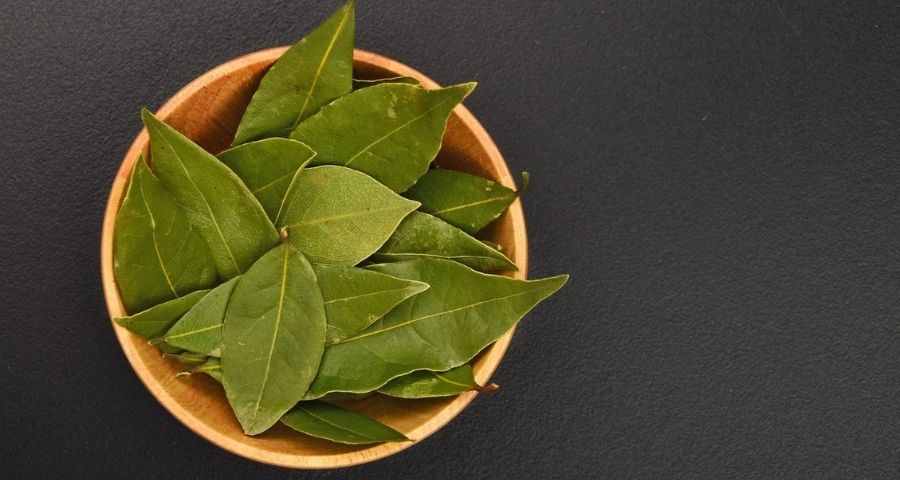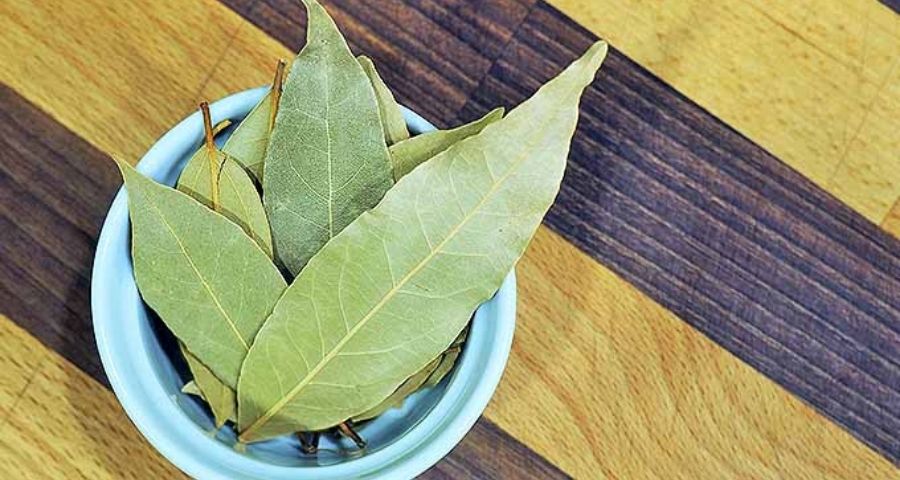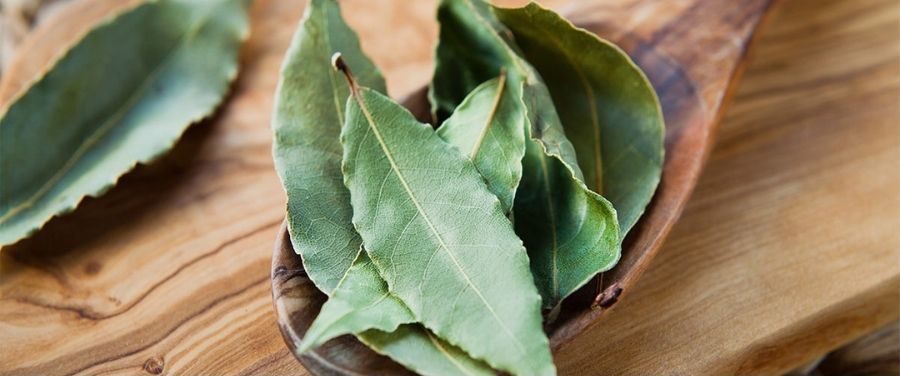Overview
Bay leaf is easily available in every Indian kitchen. It is a spice that is used to enhance flavor and aroma in dishes. Bay leaves look somewhat like the leaves of Eucalyptus. You will be surprised to know that using it can prevent many health diseases.
There are many health advantages of using this medicinal leaf in Ayurveda. Therefore, in this article, we are going to discuss how bay leaf can be beneficial for your health. Also, you will know different methods of using it and some of its health side-effects.
What is Bay Leaf?
The scientific name of bay leaf is Laurus nobilis. Its common names include bay laurel, true laurel, bay tree, sweet bay, Grecian laurel, daphne, laurel, laurel común, Laurier vrai, Laurier d’Apollon, Laurier noble, Laurier-sauce, Laurus nobilis, Mediterranean bay, noble Laurel, Roman Laurel and True Bay. (SEE ALSO: 14 Incredible Health and Beauty Benefits of Methi Seeds or Fenugreek Seeds)
It is an aromatic leaf that belongs to the Laurus family. It has been used in medicine and food for 1,000 years. There are 2,400 to 2,500 species of bay leaves, most of which are found in East Asia, South and North America and Asia. This leaf contains flavones, tannins, flavonoids, alkaloids, linalool, eugenol and anthocyanin. Bay leaves are used only after it dries.
Bay Leaf Nutritional Value
According to the Nutrition Data, per 100 gram serving of bay leaves provide —
- Calories: 313
- Total Carbohydrate: 75 gram
- Dietary Fiber: 26.3 gram
- Protein: 7.6 gram
- Vitamin A: 6185 IU
- Vitamin C: 46.5 mg
- Niacin: 2 mg
- Folate: 180 mcg
- Vitamin B6: 1.7 mg
- Calcium: 834 mg
- Iron: 43 mg
- Magnesium: 120 mg
- Phosphorus: 113 mg
- Potassium: 529 mg
- Sodium: 23 mg
- Zinc: 3.7 mg
Benefits of Bay Leaf
Bay leaves benefits may include —

1. Bay Leaf Benefits for Diabetes:
Consumption of bay leaves can be beneficial for the people struggling with diabetes. According to a research of the National Center for Biotechnology, intake of bay leaf capsules may improve insulin levels. It can help to reduce the amount of glucose in the blood. During the research, people with type-2 diabetes were given bay leaf capsules for about 30 days. After 30 days, reduction in serum glucose from 21 to 26 percent was observed. Also, an improvement in cholesterol profile was also found.
On this basis, it can be said that bay leaves intake can reduce total cholesterol by 20 to 24 percent. (SEE ALSO: 17 Surprising Health Benefits of Turmeric)
2. Bay Leaf Benefits for Respiratory System:
Bay leaf intake can also help in relieving respiratory problems such as flu, cough, bronchitis, asthma and influenza. The extract of bay leaf have anti-inflammatory properties, so they can be considered helpful in reducing inflammation. These leaves contains ethanolic extract and some other compounds, which have positive anti-inflammatory and analgesic effect. Due to this, bay leaf can protect you against inflammation and respiratory diseases.
3. Teeth Health:
Bay leaves may also beneficial for your teeth. Scientific studies reveal that its twigs contain some volatile oil at normal temperatures, which can help to improve blood flow.
It is also rich in tannins such as vitamin C, which can help to tighten the gums tissue and keep them strong and healthy. Also, brushing with ash made from bay leaves can make your gums strong. Bay leaves may also help to prevent bacteria from growing in the mouth.
According to a study of the National Center for Biotechnology, bay leaf essential oil can fight against bacteria called Staphylococcus aureus found in the mouth.
4. May Help Prevent Cancer:
Science has been continuously doing research on dangerous and fatal diseases such as cancer, but the exact treatment of this disease is yet to be found. Yes, it can be prevented by taking care of food and exercise regularly. Bay leaf is also one of the foods that can help in preventing cancer. It prevents the growth of cancerous cells. It has been confirmed in a study of the National Center for Biotechnology. This study also states that bay leaf properties can prevent stomach cancer.
According to an another research, bay leaf extracts have some anti-cancer effects, which can inhibit the growth of breast cancer. The anti-proliferative and cytotoxic properties present in bay leaves may prevent breast cancer from growing. Therefore, it can be said that the benefits of eating bay leaves include cancer prevention.
5. In Healing Wounds:
Bay leaves can help to heal the wound in a better way. According to a study, bay leaf extract can help in the development of connective tissues that help in healing the wound. (SEE ALSO: 13 Surprising Health Benefits of Cinnamon)
At the same time, bay leaf extract can also enhance the complex chemical reactions such as hydroxyproline, which helps in healing the wound quickly.
6. Reduces Inflammation:
The benefits of bay leaves can also be seen in pain and inflammation. An Australian study revealed that bay leaves may inhibit the activity of an enzyme called COX-2. This enzyme can increase inflammation in the body. In addition to this, cineole present in this leaf may also act to fight inflammation.
7. Protect Against Fungal Infections:
Bay leaf contains anti-fungal properties. It can work effectively against yeast infections, especially Candida albicans. Therefore, essential oil of bay leaves can be used for skin fungal infections.
8. Bay Leaf for Weight Loss:
If you’re facing the problem of increasing weight, then bay leaf can benefit. Bay leaf is one of the medicinal herbs that can control appetite. Therefore, after consuming it you can avoid taking extra calories and keep the weight under control. However, there is no scientific evidence to confirm this.
9. Kidney Health:
Bay leaf extract is traditionally used to treat urinary and kidney stones. It can be effective in relaxing kidney muscles directly. Bay leaf contains lauric acid, which can help to relieve kidney problems. According to a research of the National Center for Biotechnology, sankol herbal drop has been used in a variety of herbs including bay leaves. These drops may help to improve kidney’s health.
10. For Cholesterol and Heart Health:
Bay leaves can also be used to lower cholesterol levels. A research confirms that ethanol extracts obtained from bay leaves can be helpful in lowering cholesterol serum levels. These extract contains some phenolic compounds, which may be beneficial in reducing bad cholesterol (LDL or low—density lipoprotein) due to its antioxidant activity. At the same time, the level of good cholesterol (HDL or high—density lipoprotein) increases. Healthy levels of cholesterol may also lead to good heart health. On this basis, it can be said that consumption of bay leaves may help in maintaining cholesterol and cardiovascular functioning.
11. For Skin:
Bay leaves are very beneficial for the skin. Therefore, its essential oil is used in the cosmetic industry to make creams, perfumes and soaps. It can help to deeply cleanse the skin, as it has astringent properties. Also bay leaves can be used in skin rashes and protection from insects and mosquitoes. (SEE ALSO: Top 19 Health Benefits of Ginger)
In an another research, bay leaves have also been found effective in reducing acne inflammation. Therefore, the use of bay leaves can be said to be beneficial for the skin.
12. For Hair:
Bay leaves can be beneficial for your health and skin as well as your hair. It can help to keep hair roots away from fungal and bacterial infections, as it is rich in anti-fungal and anti-bacterial properties. Due to these properties, essential oil extracted from bay leaves is used in dandruff and psoriasis-protecting lotion.

Dosage
The appropriate dose of bay leaf depends on several factors such as age, health, and several other factors. At this time there is not enough information to determine the right dosage of bay leaf.
How to Use Bay Leaf?
Bay leaf can be used in many ways; including —
- Bay leaf is a spice, so it can be used to enhance the flavor of dishes.
- It is used in spicy dishes such as chicken, biryani, mutton curry and casserole.
- Bay leaves can also be added to sweet dishes like kheer.
- Many people also use bay leaves in black tea.
- For hair, boil some bay leaves in a cup of water and after about 15 minutes remove the leaves from water. After cooling, apply it to the hair and scalp after shampooing.
- Bay leaf oil can be used to relieve pain and inflammation. For this, apply a few drops of its oil to the affected area and massage it gently with hands.
- For problems like colds boiling bay leaves can be drunk in water.
How to Preserve Bay Leaves for A Long Time?
Fresh bay leaves can be kept in a sealed zip plastic bag and can be stored in the refrigerator for 1 to 2 weeks. At the same time, store the dried bay leaves in a dry and air tight container. Bay leaves should never be kept in the open, because their fragrance decreases quickly.
Side Effects of Bay Leaf
What are The side-Effects of Bay Leaves?
The side-effects of bay leaves include —
- There is not enough information about the intake of bay leaf or its supplements during pregnancy or breast—feeding. Be sure to ask your doctor or health care provider before consuming it during pregnancy.
- These leaves may slow down the central nervous system (CNS) by reacting with anesthesia drugs. Therefore, stopping the intake of bay leaves or any of its supplements for at least two weeks before surgery may prove to be the right decision.
- Essential oil made from bay leaves can cause allergic reactions on sensitive skin.
- Diabetes patients should consume bay leaf under the supervision of a doctor.
Take Away
Bay leaves contains anti-inflammatory, anti-tumor, anti-fungal, anti-proliferative and cytotoxic properties. It may support heart health, reduce bad cholesterol and reduce inflammation. In addition, bay leaves are also beneficial in cancer, diabetes, weight loss and respiratory health.
But, keep in mind that if any health side-effects are seen during its regular use, then one should see a doctor immediately. If you have any question or suggestion, leave in the comment section below.
REFERENCES:
- Bay Leaf; Author: Saima Batool, Rasheed Ahmad Khera, Muhammad Asif Hanif and Muhammad Adnan Ayub; PMCID: PMC7152419. doi: 10.1016/B978-0-08-102659-5.00005-7
- Bay Leaves Improve Glucose and Lipid Profile of People with Type 2 Diabetes; Authors: Alam Khan, Goher Zaman and Richard A Anderson; PMID: 19177188, PMCID: PMC2613499. DOI: 10.3164/jcbn.08-188
- Anti-inflammatory and anti-hyperalgesic evaluation of the condiment laurel (Litsea guatemalensis Mez.) And its chemical composition; Author: Simão da Silva, Kathryn Ana Bortolini, Klein-Junior, Luiz Carlos, Cruz, Sully M., Cáceres, Armando, Quintão, Nara Lins Meira, Monache, Franco Delle, Cechinel-Filho, Valdir; ISSN: 0308-8146.
- Emerging Trends of Herbal Care in Dentistry; Authors: Gunjan Kumar, Md. Jalaluddin, Purnendu Rout, Rajat Mohanty, and C.L. Dileep; PMCID: PMC3782986, PMID: 24086929. doi: 10.7860/JCDR/2013/6339.3282.
- Evaluation of In Vitro Antiurolithiatic Activity of Laurus nobilis Leaves Article Information; World Journal of Gastroenterology, Hepatology and Endoscopy, 2019.
- Antibacterial and Antibiofilm Activities of Laurus Nobilis L. Essential Oil Against Staphylococcus Aureus Strains Associated With Oral Infections; Authors: A Merghni, H Marzouki, H Hentati, M Aouni and M Mastouri; PMID: 26657812. DOI: 10.1016/j.patbio.2015.10.003.
- Molecular Size Fractions of Bay Leaf (Laurus Nobilis) Exhibit Differentiated Regulation of Colorectal Cancer Cell Growth in Vitro; Authors: Louise Bennett, Mahinda Abeywardena, Sharon Burnard, Santina Forsyth, Richard Head, Kerryn King, Glen Patten, Peter Watkins, Roderick Williams, Dimitrios Zabaras and Trevor Lockett; PMID: 23859043. DOI: 10.1080/01635581.2013.796999.
- Evaluation of the Volatile Oil Composition and Antiproliferative Activity of Laurus nobilis L. (Lauraceae) on Breast Cancer Cell Line Models; Author: Rana Abu-Dahab, Violet Kasabri and Fatma Ulku Afifi; ACG Publications.
- Anti-inflammatory Potential of Native Australian Herbs Polyphenols; Authors: Yu Guo, Karunrat Sakulnarmrat and Izabela Konczak; PMID: 28962255. PMCID: PMC5598408. DOI: 10.1016/j.toxrep.2014.06.011.
- Prostaglandins and Inflammation; Author: Emanuela Ricciotti, PhD and Garret A. FitzGerald, MD; PMCID: PMC3081099. NIHMSID: NIHMS271399. PMID: 21508345.
- Laurus Nobilis Leaf Extract Controls Inflammation by Suppressing NLRP3 Inflammasome Activation; Author: Eun Hye Lee, Jin Hak Shin, Seon Sook Kim, Hanbyeol Lee, Se-Ran Yang and Su Ryeon Seo; PMID: 30387132. DOI: 10.1002/jcp.27434.
- Antifungal Activity, Mode of Action and Anti-Biofilm Effects of Laurus Nobilis Linnaeus Essential Oil Against Candida Spp; Authors: Larissa Rangel Peixoto, Pedro Luiz Rosalen, Gabriela Lacet Silva Ferreira, Irlan Almeida Freires, Fabíola Galbiatti de Carvalho, Lúcio Roberto Castellano and Ricardo Dias de Castro; PMID: 27771586. DOI: 10.1016/j.archoralbio.2016.10.013.
- Influence of extraction methods of bay leaves (Syzygium polyanthum) on antioxidant and HMG-CoA reductase inhibitory activity; Authors: Lanny Hartanti, Stefania Maureen Kasih Yonas, Josianne Jacqlyn Mustamu, Sumi Wijaya, Henry Kurnia Setiawan, and Lisa Soegianto; PMCID: PMC6458466. PMID: 31008409. doi: 10.1016/j.heliyon.2019.e01485.
- Bay Leaves Improve Glucose and Lipid Profile of People with Type 2 Diabetes; Author: Alam Khan, Goher Zaman and Richard A. Anderson; PMCID: PMC2613499. PMID: 19177188. doi: 10.3164/jcbn.08-188.
- In Vitro and in Vivo Effects of Laurus nobilis L. Leaf Extracts; Author: Biljana Kaurinovic, Mira Popovic and Sanja Vlaisavljevic; PMCID: PMC6263372. PMID: 20657487. doi: 10.3390/molecules15053378.
- Suppression of Propionibacterium acnes-Induced Skin Inflammation by Laurus nobilis Extract and Its Major Constituent Eucalyptol; Author: Eun Hye Lee, Jin Hak Shin, Seon Sook Kim, Ji-Hye Joo, Eunmi Choi and Su Ryeon Seo; PMID: 31319552. PMCID: PMC6678599. DOI: 10.3390/ijms20143510.
- Identification, Functional Characterization, and Evolution of Terpene Synthases from a Basal Dicot; Authors: Mosaab Yahyaa, Yuki Matsuba, Wolfgang Brandt, Rachel Davidovich-Rikanati, Adi Doron-Faigenboim, Einat Bar, Alan McClain, Efraim Lewinsohn, Eran Pichersky, and Mwafaq Ibdah; PMCID: PMC4634067. PMID: 26157114. doi: 10.1104/pp.15.00930.
- Chemical Composition and Antimicrobial Activity of Laurus nobilis L. Essential Oils from Bulgaria; Authors: Hafize Fidan, Galina Stefanova, Iliana Kostova, Stanko Stankov, Stanka Damyanova, Albena Stoyanova and Valtcho D. Zheljazkov; PMCID: PMC6412751. PMID: 30813368. doi: 10.3390/molecules24040804.
- Health Benefits of Bay Leaf, Health Action; Author: Kuna Aparna; DOI: 10.13140/RG.2.2.30801.02408.
- Antihypertensive Indigenous Lebanese Plants: Ethnopharmacology and a Clinical Trial; Authors: Ali A. Samaha, Mirna Fawaz, Ali Salami, Safaa Baydoun and Ali H. Eid; PMCID: PMC6681041. PMID: 31330767. doi: 10.3390/biom9070292.
- How mammals stay healthy in nature: the evolution of behaviors to avoid parasites and pathogens; Author: Benjamin L. Hart and Lynette A. Hart; PMCID: PMC6000140. PMID: 29866918. doi: 10.1098/rstb.2017.0205.
